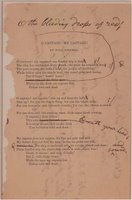An Eery Tale!
 Do you know of an English mathematician and philosopher William Kingdon Clifford? Well, now you will; a little! Born on May 4, 1845, at Exeter, went to King's College, London at the age of 15 and was elected a fellow in Trinity College, Cambridge in 1868. He became a professor of mathematics and mechanics at University College, London in 1871 and in 1874, became a fellow of the Royal Society. He was not much happy with the excessive analytic tendencies of Cambridge mathematicians and along with Hermann Grassmann (about whom, I know little) invented what is now termed Geometric Algebra, a special field being Clifford Algebra named in his honour.
Do you know of an English mathematician and philosopher William Kingdon Clifford? Well, now you will; a little! Born on May 4, 1845, at Exeter, went to King's College, London at the age of 15 and was elected a fellow in Trinity College, Cambridge in 1868. He became a professor of mathematics and mechanics at University College, London in 1871 and in 1874, became a fellow of the Royal Society. He was not much happy with the excessive analytic tendencies of Cambridge mathematicians and along with Hermann Grassmann (about whom, I know little) invented what is now termed Geometric Algebra, a special field being Clifford Algebra named in his honour.
I suppose you are beginning to appreciate that he was a good mathematician. But my eery tale begins now. He was the first to suggest that Gravitation might be a manifestation of an underlying geometry! In Volume One of Lectures and Essays (edited by FR. Pollock and L. Stephen and published by Macmillan in 1879) in one of several references, Clifford ‘anticipates’ Einstein’s curvature of physical space in these words:
I am supposed to know that the three angles of a rectilinear triangle are
exactly two right angles. Now suppose that three points are taken in space,
distant from one another as far as the Sun is from Alpha Centauri, and the
shortest distances between these points are drawn so as to form a triangle...
Then I do not know that this sum would differ at all from two right angles;
but also I do not know that the difference would be less than ten degrees.
He died of tuberculosis on March 3, 1879. Eleven days after his death, Albert was born to Einstein and goes on to develop a geometric theory of gravitation [inspite of being known for poor performance especially in Math, in his school ;) ].
Well thats the end of the tale and I do find it eery!
That apart Clifford seems to have used his imagination in anticipating other developments that came in his future. In Volume One (pp. 237-238) he writes:
Now, whatever may turn out to be the ultimate nature of the ether and of
molecules, we know that to some extent at least they obey the same dynamic
laws, and that they act upon one another in accordance with these laws.
Until, therefore, it is absolutely disproved, it must remain the simplest and
most probable assumption that they are finally made of the same stuff – that
the material molecule is some kind of knot or coagulation of ether.
Was he suggesting some kind of string theory?
He is also known for his philosphical musings and I state here one of his quotes which I seem to identify with:
"There is no scientific discoverer, no poet, no painter, no musician, who will not tell you that he found ready made his discovery or poem or picture - that it came to him from outside, and that he did not consciously create it from within."
Jade.

No comments:
Post a Comment